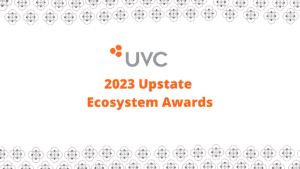Be comfortable doing stuff for the first time, without a roadmap.
By: Stan Linhorst | Syracuse.com
Nasir Ali is CEO and co-founder of Upstate Venture Connect.
The non-profit organization connects entrepreneurs across Upstate New York, aiming to create a culture similar to Silicon Valley, where talent, opportunity, mentoring, know-how and entrepreneurial instincts flow easily among old and new companies.
It’s important to Upstate because Ali says Kauffman Foundation research shows that 1 percent of new companies produce 40 percent of new jobs. He sees the pace of innovation accelerating and the cost of launching a digital-age business deflating.
Ali’s partner in founding UVC is Martin Babinec, who came home to Little Falls after founding Tri-Net in 1988 in Silicon Valley. Both men saw that other Upstaters had launched great startups in the last couple decades. But they went elsewhere to do it, creating all those new jobs in other places. Ali and Babinec decided to ask successful entrepreneurs: Why did you leave Upstate?
In presentations, Ali first lists conventional thinking about why entrepreneurs leave CNY:
“Weather is awful.”
“Taxes are too high.”
“Regulations are crushing.”
“Not enough venture capital.”
When you interviewed entrepreneurs who left, were these the reasons?
No. They said two things:
“I did not know anyone in Upstate N.Y. who had started a business and could help me.”
“In (fill in the blank), everyone I met connected me to others, and I was on my way!”
We spoke to all these entrepreneurs who grew up here and left or came here to get an amazing education at our incredible institutions and left to start companies.
They moved to places that had severe weather phenomena and definitely higher tax rates, higher regulatory burdens, higher costs of living. Nobody’s moving to New York City because the cost of living is low. Nobody’s moving to Boston for that reason either. Or Silicon Valley. Or any part of California.
The thing that made them want to be in those communities was the network, the connectivity and the access to people that could help them succeed.
They were willing to live with the high prices. They were willing to live with the high regulations. They’re willing to make that tradeoff to build world-class companies.
When you interviewed entrepreneurs, they said: “I did not know anyone in Upstate New York who had started a business and could help me.”
Yeah.
Please elaborate.
We ran an experiment in 2008-2009 that became successful: TheSyracuse Student Sandbox.
If you find 10 or 20 or 30 college students that want to start a business and you keep them here over the summer and introduce them to the local business community, 60 percent of them would graduate and stay here. All of a sudden they have a network.
You have colleges and universities across the Upstate region training 500,000 people. With a little effort and creativity, it’s possible to make those types of town-gown entrepreneurial connections every summer. You have to identify who’s willing to step up and create an anchor relationship in our community for someone who could go on to found and build a company.
We now have a group called the UNY50. These are people who are successful and want to give back. They said: I don’t mind meeting people who are thinking about starting a business. I am fine with taking the time to help them. If there are ways I can assist them, I don’t mind opening doors or providing advice — whatever it takes to help them succeed.
We spend our time building those types of connective networks.
What about you? Did you grow up in Syracuse?
No, I grew up in Pakistan, in Karachi, a city on the Arabian Sea.
What brought you to Syracuse?
The technical term is “trailing spouse.” (Laughs)
My wife (Uzma Iqbal) and I were living in Washington, D.C. She finished her training as a cardiologist. After looking at a lot of options, she really liked this practice in Syracuse.
Tell me about your background.
I came to the U.S. to go to college. I got my undergraduate degree in physics from Princeton. After taking a year off, I went to Yale to get my masters in finance and operations management.
Following that, in 1991, I moved to Washington, D.C., to work for Arthur D. Little. I did a lot of technology turnaround work for a company called MGA. I started my own company. I worked for Booz Allen Hamilton.
I always worked at the intersection of business and technology.
Were you in leadership roles growing up?
I had an ordinary childhood, going to school, coming home and going out on the street to play with the other kids.The biggest advantage that I had was that I was allowed to pursue my curiosity. The rule in our house was: If you want to get a book, no one’s ever going to say no.
My mom (Badar) is a physician and also taught at med school. My dad (Sabir) is an entrepreneur. Both of them had high expectations for me. They basically said: Enjoy what you do. There’s no limit to what you can achieve if that is the case.
Tell me about important influences.
I grew up bilingual. (Urdu and English) I spoke English fluently, and I read it.
I had a teacher in high school, Mrs. Naz Ahsanuddin. I was a junior when I found her. After that, I was no longer reading to consume; I was reading to understand. I was no longer writing to fill up the paper; I was writing to communicate. She taught me that. That was the moment at which the world started to make sense.
You’ve held leadership roles in several organizations and now advise leaders of startups. What’s your advice for a new leader?
Leaders have to be comfortable doing stuff for the first time.
The fact is, when you’re in a leadership position, what lies ahead of you is shrouded in fog — not always clear. Things shift. So be comfortable with that.
The second thing is that I think leadership is more about whether people are ready to follow you and work with you than it is about whether you want to be a leader.
That means you have to have a good ability to listen and to engage. You’re taking a group of people into an arena where there are not necessarily roadmaps. You have to communicate back to them about why you are doing this and where you want to go. You also have to be willing to understand that each person has a certain capacity, a capability, an intuition, they bring to the mix. You have to be able to take that and benefit from it. That’s how you’re going to move the whole group forward.
Another critical piece: It has to be a group activity. It’s not: “I have all the answers.”
Most entrepreneurs that we deal with become leaders because they are the ones that care about what they are doing. Everyone else comes along after they have built something and naturally assumes they are the leader. That’s a big transition for every entrepreneur. All of a sudden you have the responsibility for this enterprise and all of these people are looking to you.
Most of the leaders I deal with are entrepreneurs. What they are driven by is: This is where I think we should be going, and I’m going to start.
If you believe in something, you can’t let others’ beliefs drive your decision making. The only way to make decisions is to get information — data — that allows you to determine whether a path is right or wrong.
If you are in a leadership position or if you’re starting a company, you have to be comfortable with failure. Those around you also have to understand that every success is essentially the result of many, many, failures. Look at how many experiments Thomas Edison had to run before he found the right filament for his bulb. Every single one of those failures, somebody was probably there saying: Hey, how long are you going to keep this up? You’ve been doing this six months. You’ve tried a hundred things.
If you give up, then you’ll never know what you could have done.
What do you see as the future of startups in Central New York?
We’re living in an age where it’s possible to start a company anywhere. Absolutely anywhere. You could be in any country in any part of the world and you will find entrepreneurs.
What we have to do is create the kind of community that startups want. Like so many other communities, we are in competition with the so-called startup hubs.
We have an incredible renewable resource in all of these amazing college students that come from all over the world to our region.
Many of them would be happy to put their roots down here and build something great. They will go wherever they think they can achieve that.
The gold of today is talent, and I think we are awash in it in Upstate New York and Central New York. Whatever we can do to engage the most entrepreneurial of those students, to get them to build some connections and have some roots here, can create a new golden age for our economy. Those people are looking to make a difference; they are not just looking for a job.
Tell me about a tough challenge you had and what we can learn from it.
For me, the toughest challenge was when I had to shut down my first startup. I had never wanted anything so badly in my life as that company to succeed. I had never tried as hard at anything in my life for that company to succeed. I had never made as many promises, owed as many debts. I had done everything I possibly could and then I had to make the decision that said: OK this is not going to work.
I’ve been very fortunate. My parents are still alive. My family’s healthy. But that was the closest I felt to having lost something that was incredibly important.
What was the company?
It was called NewThink.
We were trying to build a mobile commerce device. Everything you can do today with the iPhone, in terms of transactions, was something that we were thinking about. But it was not the right time. This was 1999, and I had to close it down in 2001.
I was doing this full time. I was doing nothing but this 24 by 7. I had people who were counting on me. I had investors who were counting on me.
Letting it go from my heart was the toughest thing.
As an investor now, I look for that level of passion and commitment. If someone’s telling me I can’t really leave my job until someone pays me to do this, then that’s not a person who is going to get investment.
Investors look for people who say: I’m going to do this no matter what. So do you want to help me or not?
That’s a big part of what I look for.
And then someone who is able to bring it back and say: How do I make it fit what the market is actually looking for?
You have to be able to think about it creatively, in a visionary way, but you cannot ignore the data.
“CNY Conversations” feature Q&A interviews with local citizens about leadership, success, and innovation. The conversations are condensed and edited. They also run regularly on Sunday in The Post-Standard’s Business section. To suggest a person for CNY Conversations, contact Stan Linhorst at slinhorst@syracuse.com.


